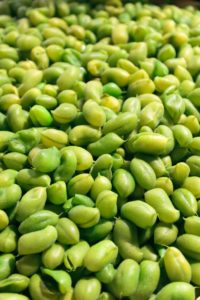Phytic acid, also known as phytate, is a well-known substance found in plants. It acts as an antinutrient – but what does that mean exactly?
Antinutrients are molecules that are part of the plant’s defense against predators. There are many different substances that act through various mechanisms, one of them being phytic.
We will also take a look at which plants phytic acid is present and how you can best deal with that information.1This applies more broadly, of course, to other antinutrients such as lectins, phytoestrogens or goitrogens, not just phytates.
Plants, as many naively assume, are not man’s best friend and favorite food. Quite oppositely they form an independent kingdom of life and as such want to survive. Antinutrients such as phytic acid are part of the chemical defense arsenal they utilize, along with mechanical protection such as thorns or bark.
Therefore, it is important to understand the nuances of each antinutrient and which parts of the plant are generally most protected. Because many of these substances are designed to directly harm predators.
What is Phytic Acid?
Phytic acid is a chemical substance that occurs in many plant parts. Its use is that of a storage form of phosphorus, which is particularly important in growing plants, such as seeds, nuts, and grains.
Chemically, phytic acid is an ester of the substance inositol. Humans also use inositol – in the past, a form called myo-inositol, was even known as Vitamin B8. Nevertheless, phytic acid is related to it only by name.
In evolutionary terms, phytates (phytate = phytic acid bound to a mineral) are the way plants hold onto precious minerals, above all phosphorus. On the flipside, Phytic acid thus strongly binds minerals, making them unavailable to our intestines. This is called chelation and particularly affects minerals such as iron, zinc calcium, and many others.2https://en.wikipedia.org/wiki/Phytic_acid
Monogastric animals (= ‘possessing only one stomach’) cannot digest phytic acid because they lack particular enzymes. Ruminants, for example, posses them and can handle phytates a lot better through the help of their sophisticated microbiome.3Phytic Acid Chemistry: Influence on Phytin-Phosphorus Availability and Phytase Efficacy
What is the Problem with Phytic Acid?
The Biological Effects of Phytic Acid
Phytic acid has an antinutritive effect, despite its primary function as a storage form.
This ‘punishes‘ predators, as various positively charged minerals become bound in phytate complexes. Phytic acid binds minerals and thus makes them unavailable. This is clearly a defense strategy.
Phytates are just one of many Antinutrients

Many other substances have a role as antinutrients as well, although they act differently. Examples are:
- Lectins (attack the inner wall of the intestine)
- Goitrogens (prevent proper thyroid function)
- Phytoestrogens (act like estrogen)
… just to name a few of the important representatives. You can read more about all of these in my post on antinutrients, which acts as a general overview of this branching topic.
What is with the antioxidative Properties of Phytic Acid?
Phytic acid binds things. Therefore, it can have an antioxidative effect in the intestine when it binds heavy metals or free radicals.
This leads to exciting applications in the therapeutic field and is therefore positively associated with some diseases. Nevertheless, it is important to understand that this is epidemiological data and very misleading.
The Fallacy of Confusing Medicine with Food
One should not commit the fallacy of labeling medicinal plants as food. While there are medicinal benefits for aspirin or metformin, both are far from being everyday food.
I see phytic acid in a similar way:
All power to this substance if it can offer help as a short-term therapy for a targeted medical condition. But that doesn’t mean it has a place in everyday nutrition. Especially because the plant parts containing phytic acid usually come with many other defense molecules and thus increasing issues.
Rather support your Body’s intrinsic Systems
Instead of looking outside for wonder molecules, the priority should be to support your own immune and redox systems4Spoiler: abundant animal amino acids and micronutrients, as well as optimized quantum health are the way to go here…. To do this, make sure you’re providing them with all the nutrients you need, rather than relying on external, low-quality sources, forever on the lookout for the next big ‘fix’ or ‘superfood’.
Your body knows what to do and how to stay healthy if you give it the input it needs – and by input I don’t just mean nutrients, but also things like light, electrons, air, or a social context. Health cannot be seen reductionistically, but only in the whole picture and in light of evolution.
Which Foods contain Phytic Acid?
The rationale is simple: all plant parts that want to grow, are part of energy production, or are storage forms of energy are defended by plants.
We can say that nuts, seeds, grains, seeds, and legumes are extremely strongly defended. Leaves, roots, and tubers less so, while fruits are defended only very slightly.
We humans do indeed have the potential as omnivores to cope with some of them, yet factors such as seasonality, redox and the latitude at which we live are crucial. We have no potential to eat tons of them, all year round. This makes the whole issue enormously complex and individual. While the occasional potato or the odd tomato is generally not a problem5Unless you are genetically or epigenetically prone to autoimmune diseases – then both can definitely cause problems as part of the nightshade family. Therefore, individually!, daily grains or the sheer bulk from all plant sources are.
Next, let’s take a look at the most polluted parts of the plant.
Grains
Cereals are growing plants. They are extremely strongly defended, with substances like our friend the phytic acid, but also gluten, gliadin, or enzymatic inhibitors. They also appeared first in our diet since the Neolithic Revolution circa ~12,000 years ago. Even then, grains were heavily processed by milling, sourdough fermentation, or nixtamalization.
In terms of phytic acid, grains are way out in front with amounts ranging from 0.5 – 8.5g per 100g. Most is found in the hull of cereals and consequently meal, whole grains and bran are the most contaminated.
Nuts
Nuts, like seeds or grains, are young plants. Nuts are among the most defended plant parts in the kingdom of plants.
The most toxic substance in this world, rhizin, is found in a seed.
Nevertheless, this is an extreme of the spectrum, many substances are not lethal, but chronically do their harm. So do the various antinutrients, such as lectins or enzymatic inhibitors.
In our diet, nuts only grow seasonally throughout autumn and are therefore a very limited part of our diet. However, as we know from indigenous people, if they were ate they were extensively prepared by soaking them in salt water, drying them under the sun, or even letting them sprout, in order to drastically reduce the content of antinutrients. This is because all of these methods fool the nut into thinking it needs to sprout – thus drastically and naturally reducing its protective nutrients.
Nuts also contain the highest levels of phytic acid with 0.2g – 9.4g per 100g.
Legumes

Legumes are another form of how plants reproduce. They are also extremely strongly defended, especially with lectins and phytoestrogens.
In human nutrition, legumes were probably little consumed because wild varieties look quite different from today’s cultivated species. And if they were eaten (of which I know of no indigenous tribe so far), they were definitely prepared very time-consumingly.
Phytic acid is also present with the levels falling into the midfield of 0.2-2.6g per 100g. But as mentioned they are also heavily protected by other antinutrients.
The Reasons why Humans invented Sourdough
Traditional processing methods became very important since the Neolithic Revolution to free nutrients and reduce plant toxins.
Before that, such methods were certainly also used to make plants edible, but the amount of dietary energy coming from animal sources was certainly much more predominant. Plants were often seen more as a means of survival.
Sourdough fermentation is a method to reduce the content of various antinutrients in grains by the help of microorganisms. Other methods falling into the same category are the nixtamalization of corn or the drying, soaking, and sprouting of nuts. A great book that addresses all of this is Paleoanthropologist Bill Schindler’s Eat like a Human*.
However, even the end products of traditional preparation methods still contain antinutrients and were certainly not a huge part of our daily diet for the longest part of our evolution. Animal sources of energy and more non-toxic plants such as leaves, herbs, or fruits predominated, supplemented with more strongly defended plants. We truly have it backwards in our Western standard diets.
The two Ways to cope with Antinutrients are Elimination or Preparation

If you don’t eat antinutrients, you don’t have any problems. But why do I think elimination is a good approach?
Many of the plant parts that are rich in phytic acid are also extremely rich in many other antinutrients:
- They come with a whole bag of problematic substances.
- Also, many of us do not have the time to prepare these plant parts in a time-consuming manner.
- Likewise, many of these plants don’t have benefits that can’t be found anywhere else in food.
Many animal sources or less defended plants have far more bioavailable nutrients that often can’t be found anywhere else either. Take for example beef liver, muscle meat, or even green leafy vegetables.6Green leafy vegetables also contain repellents that can become problematic such as oxalates. To detoxify these, your redox systems need to be working well.
To me, these are an overwhelming number of net negatives, as you would say economically. In the end it’s a personal a cost/benefit calculation. And while a handful of nuts in season can be perfectly good, quantity also makes the problem. Personally, I eat nuts in season in collectible quantities but avoid the grains, legumes, and seeds. I also avoid traditionally processed products from these such as nixtamalized corn or sourdough. I see far more benefits for less cost otherwise when you look at the nutrients.
However, this is ultimately a decision you must make for yourself. I hope today’s excursion into the world of phytic acid and antinutrients has been helpful.

Fußnoten & Quellen
- 1This applies more broadly, of course, to other antinutrients such as lectins, phytoestrogens or goitrogens, not just phytates.
- 2
- 3
- 4Spoiler: abundant animal amino acids and micronutrients, as well as optimized quantum health are the way to go here…
- 5Unless you are genetically or epigenetically prone to autoimmune diseases – then both can definitely cause problems as part of the nightshade family. Therefore, individually!
- 6Green leafy vegetables also contain repellents that can become problematic such as oxalates. To detoxify these, your redox systems need to be working well.